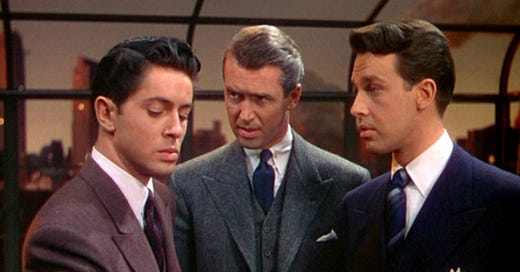Heartland: Rope (1948)
Alfred Hitchcock’s tale of suspense is a masterclass of cinematic techniques and storytelling.
Click here for Heartland Film Festival showtimes and tickets!
I’m so glad that the Heartland Film Festival chose Alfred Hitchcock’s first color-film as one of their classic throwbacks. I’d never seen this one, but give me a break, he directed over 50 features. It was truly fascinating to watch Hitchcock, a true master of his craft, direct this work. Rope contains top-notch storytelling, camera work, and dialogue working in synchronous harmony to build suspense. For these reasons, I imagine that it’s probably necessary viewing in film schools.
The setting: a penthouse dinner party where a murder has just occured. Hitchcock weaves this suspenseful story within the confines of this single-setting. Now, a story like this might be limited in its location, but there are so many techniques used to bring this space to life. Other films that take place in one setting often make me feel claustrophobic like “Devil” (2010) or “Buried” (2010).
There is the single-shot technique where the camera doesn’t break away (much like the cinematography seen in the 2019 war film “1917”). Instead, the audience glides between characters, conversations, and sometimes even trails off alone to take note of things the characters don’t notice.
The luxurious penthouse has a panoramic view of the New York City skyline, and intricate set pieces change throughout the course of the day into evening. All of that, and I haven’t even mentioned much of the story...
The film opens up with the rope strangulation of a man named David Kitley. His murderers are two of David’s former prep school classmates, Brandon Shaw (John Dall) and Phillip Morgan (Farley Granger). The purpose of the murder: killing for killing’s sake.
Brandon, the more sadistic of the two killers, talks with a creepy sort of charm (how I imagine a superficially charming person like Ted Bundy would have been). Brandon takes pride in their murder saying, “Murder can be an art too. The power to kill can be just as satisfying as the power to create.” The rest of the film is spent as Brandon tries to “create” his twisted, artful masterpiece for his own amusement and for the adoration of Phillip. The murder is known only to himself, his accomplice Phillip, and the audience.
Phillip’s guilt brings humanity into the story, as his reaction is more akin to how a non-psychopathic person would feel about murdering a person. Whereas Brandon has no regrets, Phillip is stricken by an immediate remorse that eats at him for the duration of the film.
Before Brandon has a chance to start rationalizing things for Phillip, they stuff David’s body into a large wooden chest in the living room and the dinner guests start arriving. On the list of guests: David’s parents, David’s girlfriend, a prep school classmate, and their prep school headmaster Rupert Cadell (James Stewart). A brief aside: Stewart would go on to work with Hitchcock in “Rear Window” (1954), “The Man Who Knew Too Much” (1956), and “Vertigo” (1958).
Brandon’s sick game starts to take shape when their former prep school headmaster starts noticing things are amiss. A game of cat-and-mouse ensues, as the former headmaster starts to play detective and pick holes in the story. All of this builds to a “hold on to your seat” final act.
Top-notch pick to feature this year.





